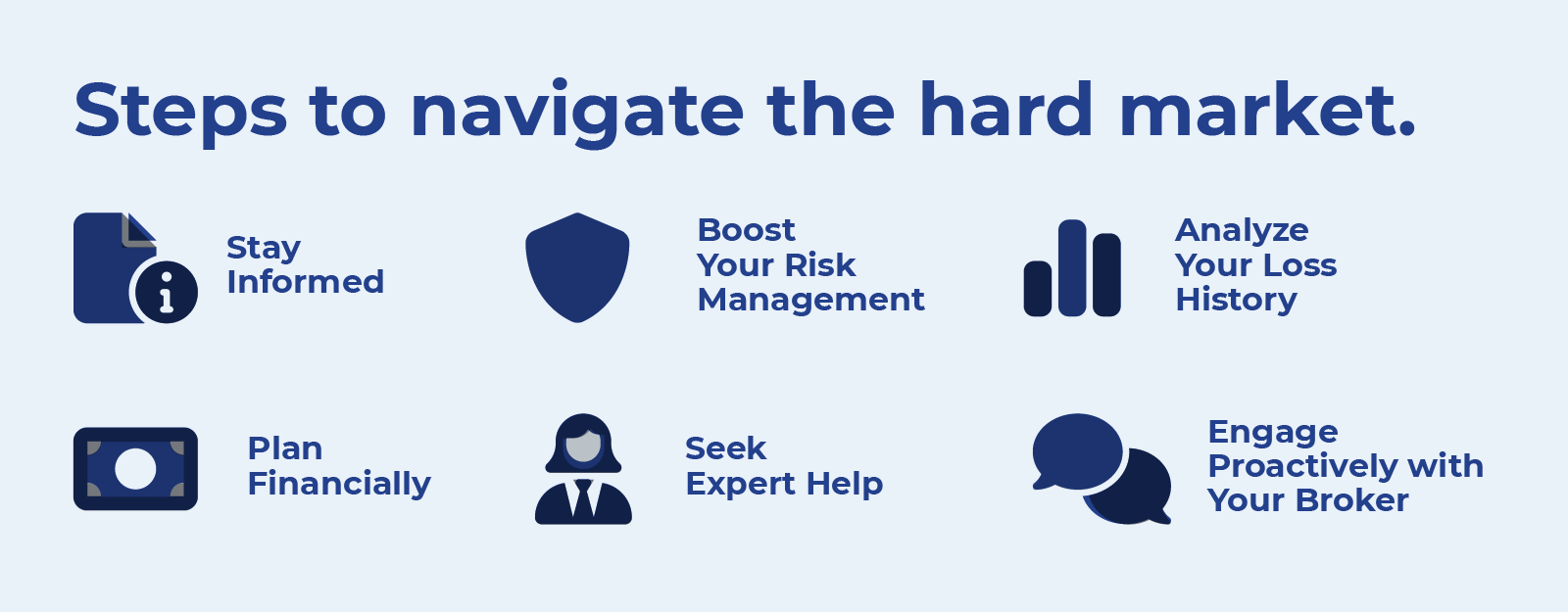The world of insurance can sometimes appear as unpredictable as the weather. One day it's sunny and premiums are affordable, the next there's a storm brewing and rates start climbing. These changes are often influenced by the cycle of "soft" and "hard" markets in the insurance industry. To guide you through these fluctuations, let's dive deeper into understanding these terms and how you can navigate them effectively.
What is a hard market? Understanding the insurance market cycle.
Insurance, much like many other industries, follows a cyclical pattern:

- Soft Market: Think of this as the 'summer' of insurance. During this phase, there is an abundance of insurance availability, leading to stable or even decreasing premiums. Insurance companies are more flexible with underwriting standards, offering broader coverage, and are in intense competition for your business.
- Hard Market: Now, imagine winter. It's a phase marked by a tightening of insurance availability. Premiums rise, sometimes sharply, and underwriting criteria become stricter. Insurance companies might reduce the limits they offer, add exclusions to policies, or even withdraw from certain market segments altogether.
The transition from a soft to a hard market doesn’t happen overnight. Various factors, often complex and interrelated, lead to a shift.
What factors lead to a hard market?
Several factors contribute to a market's turn:
- Economic Pressures: Inflation, labor costs, and increasing material prices raise the cost of claims. Construction costs have surged, wages for skilled workers have increased 5-6% per year, and vehicle repair costs are up by approximately 20%.
- Weather-Related Losses: Major disasters like hurricanes, wildfires, and storms lead to higher insurer payouts.
Underwriting Losses: When insurers pay out more in claims than they collect in premiums, they must adjust pricing and policies. - Legal & Litigation Trends: Rising attorney involvement, larger jury awards, and increased litigation costs contribute to "social inflation," pushing premiums higher. Claims with attorney involvement tend to have higher payouts and longer settlement times, further driving up costs.
- Reinsurance Costs: Insurers rely on reinsurance (insurance for insurance companies) to manage large losses by spreading risk, stabilizing premiums, and ensuring financial stability. However, major disasters force reinsurers to increase rates across all markets.
In Upstate New York specifically, we deal with various factors that could affect your insurance costs during a hard market. These factors include:
- Severe Weather Events: Snowstorms, ice storms, and flooding contribute to increased claims.
- Aging Infrastructure & Housing Stock: Older homes require costly updates, such as electrical, plumbing, roofing, etc., leading to higher repair expenses.
- Road Conditions: Harsh winters accelerate vehicle wear, and poor road conditions lead to frequent auto claims.
What to expect.
In the heart of a hardening market, you can anticipate:
Costlier Coverage: Premiums can increase, sometimes without warning.
Tougher Approval: Getting coverage might involve jumping through more hoops.
Policy Changes: There could be more exceptions or conditions in your coverage.
Fewer Options: Some insurance companies might decide not to offer policies in particularly risky markets.

Steps to navigate the hard market.
Don't be disheartened. Here's how you can weather the storm:
- Stay Informed: Knowledge is power. Understand the reasons behind changes in your premiums.
- Boost Your Risk Management: A well-maintained property or a business with good safety practices is always more appealing to insurers.
- Analyze Your Loss History: Knowing your past claims can give you negotiating power.
- Plan Financially: Recognize that during hard markets, you might need to allocate a higher budget for insurance.
- Seek Expert Help: A seasoned insurance broker can be your compass. They can help you find the best deals and guide you in making informed decisions.
- Engage Proactively with Your Broker: The earlier you start your renewal discussions, the better positioned you'll be.
The cycle between soft and hard markets is inevitable. Yet, with understanding and preparedness– and with MetzWood as your insurance partner–you can navigate it efficiently. For personalized guidance tailored to your situation, reach out to us today.

